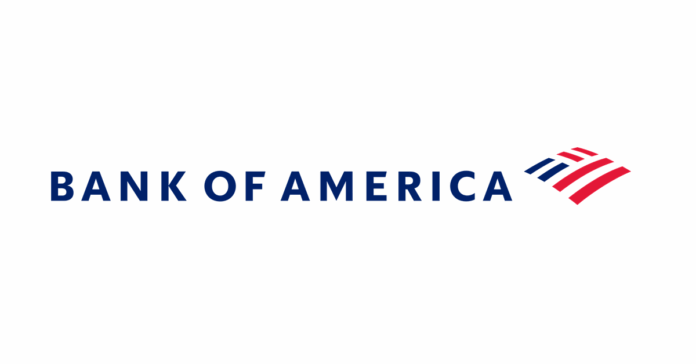CHARLOTTE, NC – July 16, 2025 – Bank of America (BAC), a titan in the global financial landscape, today announced its second-quarter 2025 financial results, showcasing a robust performance despite persistent economic complexities. The Charlotte-based institution reported a net income of $7.1 billion, marking a 3% increase year-over-year, alongside a significant 7% surge in net interest income (NII) to $14.7 billion. These figures, released on July 16, 2025, highlight BAC’s ability to maintain a steady growth trajectory, underpinned by a solid balance sheet, expanding loan portfolio, and stable deposit base.
The bank’s revenue for the quarter reached $26.5 billion, a 4% rise from the same period last year, primarily driven by the strength in NII, which was $14.8 billion on a fully taxable-equivalent basis. This NII growth reflects improved deposit spreads and a modest but consistent expansion in its loan book. Diluted earnings per share (EPS) climbed 7% year-over-year to $0.89, exceeding analyst expectations. This performance underscores BAC’s operational efficiency and strategic investments in technology and human capital, even as it navigated increased provisions for credit losses.
A Fortress of Stability: Balance Sheet and Capital Strength
Bank of America’s balance sheet continues to serve as a bedrock of financial stability. Total assets expanded by 6% year-over-year, reaching an impressive $3.441 trillion. The bank’s robust liquidity position, with global liquidity sources averaging $938 billion (up 3% from the prior year), further bolsters its financial resilience.
A key highlight of the quarter was the continued strength in deposits, which rose 5% to $2.012 trillion. Consumer deposits demonstrated particular stickiness, with average balances in the Consumer Banking segment hitting $935 billion. This figure not only represents a modest year-over-year increase but also stands a remarkable 32% above pre-pandemic levels from Q4 2019. The sheer volume of primary checking accounts—32.3 million consumer checking accounts (82% primary) and 4 million small business checking accounts—attests to the enduring strength of BAC’s customer relationships.
Complementing this deposit growth, loans and leases witnessed a healthy 9% expansion, reaching $1.147 trillion. This was primarily fueled by a 2% uptick in consumer loans to $319 billion, encompassing robust activity in credit card and auto lending. The disciplined growth in both deposits and loans signals a well-managed strategy for asset and liability management in a dynamic interest rate environment.
Diversified Engines of Growth: Segment Performance
The Consumer Banking segment emerged as a significant driver of growth, reporting revenue of $10.9 billion, an 8% increase year-over-year, and a net income of $3.0 billion. This strong performance was amplified by a 4% surge in combined credit and debit card spending, totaling $244 billion, an encouraging sign of healthy consumer activity despite lingering inflationary concerns.
The Global Wealth & Investment Management (GWIM) segment reported stable revenue of $5.9 billion, maintaining its year-over-year performance, and a net income of $1.0 billion. This segment’s strength was evident in its client balances, which grew 9% to $4.4 trillion, coupled with impressive assets under management (AUM) flows of $44 billion, indicating successful client acquisition and retention in the affluent segment.
Global Banking and Global Markets segments also made substantial contributions through fee income. Investment banking fees saw a notable rebound, benefiting from a resurgence in capital markets activity, while the Global Markets segment delivered robust sales and trading revenue, marking its 13th consecutive quarter of year-over-year growth.
Navigating Credit Quality and Capital Prudence
While Bank of America’s overall performance was strong, the bank did increase its provisions for credit losses to $1.5 billion. This uptick, from prior quarters, reflects a proactive approach to potential weaknesses in commercial real estate and select consumer portfolios amidst ongoing economic uncertainties. Despite this, net charge-offs remained stable, and delinquency rates in consumer lending remained low, suggesting a controlled risk environment.
In terms of capital strength, the bank’s preliminary Common Equity Tier 1 (CET1) ratio stood at a robust 11.5%. This figure is comfortably above regulatory requirements, providing a significant buffer against potential economic downturns and underscoring the bank’s prudent capital management.
Management’s Outlook: Cautious Optimism Amidst Evolving Conditions
CEO Brian Moynihan reiterated the bank’s commitment to “responsible growth” during the earnings presentation and call. The management team expressed cautious optimism regarding the outlook for the second half of 2025. NII is projected to stabilize or even modestly increase, potentially reaching $14.5-14.8 billion quarterly, assuming the Federal Reserve maintains interest rates within the 5.25-5.50% range without aggressive cuts.
Noninterest expenses are anticipated to rise in the mid-single digits year-over-year, driven by continued strategic investments in digital capabilities and employee compensation. Provisions for credit losses may remain elevated, ranging from $1.3-1.6 billion per quarter, contingent on evolving economic conditions. Overall, management’s guidance points towards mid-single-digit net income growth for the full year 2025, supported by sustained deposit and loan momentum, albeit tempered by potential regulatory and macroeconomic risks. This guidance aligns closely with the current analyst consensus for FY2025 EPS, which hovers around $3.60-$3.70.
Shareholder Returns and Competitive Positioning
Bank of America’s commitment to shareholder returns remains a priority. The bank repurchased $3.5 billion in shares during Q2, contributing to a trailing twelve-month total exceeding $15 billion. The common dividend was maintained at $0.26 per share, translating to an annualized yield of approximately 2.25% based on the recent closing price of $46.15. With a conservative payout ratio of around 30%, the dividend remains sustainable, making it an attractive option for income-focused investors.
In a comparative analysis, BAC’s performance stacks up favorably against its peers. While JPMorgan Chase often boasts higher return on equity (ROE), BAC’s diversified business model provides a strong foundation for stability. Its impressive 5% deposit growth outpaces many competitors, including Wells Fargo, highlighting a significant competitive edge in attracting and retaining client funds. Historically, BAC’s shares have shown a strong recovery from pandemic lows, though they still trade below pre-2008 peaks when adjusted for inflation, reflecting the ongoing challenges and evolving landscape of the financial sector, including heightened regulatory scrutiny and the emergence of disruptive fintech innovations.
Forward-Looking Opportunities and Valuation
Looking ahead, Bank of America faces potential headwinds from interest rate cuts, which could pressure net interest margins, and ongoing geopolitical uncertainties impacting global markets. However, significant opportunities lie in its continued digital transformation, evidenced by 47 million active digital users, and expansion in wealth management, where strong AUM flows signal successful affluent client acquisition. The bank’s substantial CET1 capital buffer also positions it favorably for potential strategic acquisitions or increased share buybacks should market conditions prove opportune.
From a valuation perspective, Bank of America appears to be fairly priced at its recent closing price of $46.15, with a market capitalization of approximately $359 billion. Its trailing P/E ratio of 13.1x is in line with the broader banking sector average, while a forward P/E of 12.6x suggests modest upside potential if earnings meet guidance. The price-to-book (P/B) ratio of 1.31x indicates a premium to tangible assets, which is justified by its robust return on tangible common equity (ROTCE) of 13.4%. While a traditional dividend discount model (DDM) yields a more conservative value, P/E-based targets suggest a range of $47-$50, implying a small but steady upside.
The following table provides an updated valuation snapshot reflecting Q2 2025 data:
| Metric | Description/Formula | Value (Updated with 2Q25) | Rationale/Notes |
| Current Price | Recent closing price | $46.15 | As provided. |
| Market Cap | Price × Shares Outstanding | ~$359.2B | Based on ~7.78B shares. |
| TTM EPS | TTM Net Income Attributable to Common / Diluted Shares | $3.52 | Updated: Q3’24 $0.88 + Q4’24 $0.85 + Q1’25 $0.94 + Q2’25 $0.89. |
| Trailing P/E | Price / TTM EPS | 13.1x | Reasonable for a bank; peers at 12-14x. |
| Forward P/E | Price / Forward EPS (FY2025 Consensus) | 12.6x | Implies upside to $48-50. |
| BVPS | Total Equity / Shares | $35.20 | ROE 10% supports. |
| P/B | Price / BVPS | 1.31x | Historical avg ~1.2-1.4x. |
| TBVPS | Tangible Equity / Shares | $26.50 | Excludes intangibles. |
| P/TBV | Price / TBVPS | 1.74x | Reflects ROTCE 13.4%. |
| Dividend Yield | Annualized Dividend / Price | 2.25% | Sustainable payout ~30%. |
| DDM Value | (Next Dividend × (1 + g)) / (r – g) ; g=3%, r=10% | $14.96 | Conservative; suggests overvaluation if no growth. |
| Target Price (P/E-Based) | Forward EPS × Target P/E (13x) | $47.45 | +3% upside. |
| Implied Upside/Downside | (Target – Current) / Current | +2.8% | Fairly valued; hold. |
Note on Valuations: The table uses standard banking metrics. P/E is Price divided by EPS (trailing or forward). P/B and P/TBV are Price over Book Value or Tangible Book Value per Share, derived from equity minus preferred/intangibles, divided by shares. DDM assumes perpetual 3% growth on $1.04 annualized dividend at 10% cost of equity. Targets based on consensus EPS ($3.65 FY2025) and sector-average multiples. Data from BAC’s Q2 2025 release; no margin of safety applied here, but DDM implies caution.
Bank of America’s second-quarter 2025 results reinforce its standing as a resilient and well-managed institution within the U.S. financial system. With a fortified balance sheet, diversified revenue streams, and a prudent management approach, BAC is well-positioned to navigate the evolving economic landscape. Investors will keenly watch interest rate trajectories and credit trends, but the bank’s performance trajectory suggests steady, albeit not spectacular, returns for the foreseeable future. As the global economy continues to adapt, Bank of America’s unwavering focus on client-centric growth and strategic investments positions it for sustained success in the long term.

